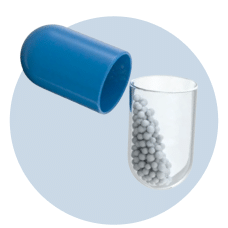Salbutamol 100 Inhaler
Product introduction
Salbutamol 100 Inhaler is called "reliever" inhalers because they give you quick relief from breathing problems when you need it. In most cases, you will be given another inhaler to prevent your symptoms (a “preventer”) and you should use this regularly every day. Salbutamol 100 Inhaler works quickly and the effects can last several hours. You can use it at any time of day, but only use it when you notice symptoms, such as coughing, wheezing, shortness of breath, tightness in the chest or you know that you are going to do an activity that can cause breathlessness. When an asthma attack happens, you should take the number of puffs your doctor recommends. There are several types of inhaler devices so make sure you know how to use your inhaler correctly, otherwise, it may not work. Do not stop using this medicine unless your doctor tells you to. If you stop, your breathing problems could get worse.
Salbutamol 100 Inhaler is generally safe and effective but may cause some common side effects which include tremors, headaches, palpitations, viral respiratory tract infections, and cough. These side effects are not often dangerous and should gradually improve as your body gets used to this medicine. There are other rare, side effects and you should call your doctor straight away if you get chest pain, a very bad headache, or very bad dizziness.
Before using Salbutamol 100 Inhaler, you should tell your doctor if you have high blood pressure, an overactive thyroid gland, a history of heart problems, diabetes, or low levels of potassium in your blood to make sure it is safe. Also, make sure your doctor knows if you are pregnant or breast-feeding before taking this medicine. This medicine can make you feel dizzy or shaky, therefore, do not drive, use tools, or machinery until you feel better. Avoid smoking as it causes damage to your lungs and will make your condition worse.
Uses of Salbutamol Inhaler
Benefits of Salbutamol Inhaler
In Asthma
In Chronic obstructive pulmonary disease (COPD)
Side effects of Salbutamol Inhaler
Common side effects of Salbutamol
- Tremors
- Headache
- Muscle cramp
- Palpitations
- Increased heart rate
- Respiratory tract inflammation
- Respiratory tract infection
- Cough
How to use Salbutamol Inhaler
How Salbutamol Inhaler works
Safety advice
What if you forget to take Salbutamol Inhaler?
All substitutes
Quick tips
- Salbutamol 100 Inhaler is used to relieve symptoms of asthma and chronic obstructive pulmonary disease (COPD) such as coughing, wheezing and breathlessness.
- It must be taken regularly to help keep the airways open at all times.
- Your doctor may regularly monitor your blood potassium levels. Inform your doctor if you notice muscle twitching, weakness, or an irregular heartbeat.
- Inform your doctor if you have a history of heart diseases or if you experience headaches, or chest pain.
Fact Box
Interaction with drugs
Patient concerns
FAQs
What would happen if I take higher than the recommended dose of Salbutamol 100 Inhaler?
Is it safe to take Salbutamol 100 Inhaler if I have heart disease?
Being a diabetic, what should I remember while taking Salbutamol 100 Inhaler?
I have started using Salbutamol 100 Inhaler and I am experiencing headaches and shakiness. Is this because of Salbutamol 100 Inhaler and will these go away?
When should I take Salbutamol 100 Inhaler?
Can I smoke if I have been prescribed Salbutamol 100 Inhaler?
Related ayurvedic ingredients
Disclaimer:
Tata 1mg's sole intention is to ensure that its consumers get information that is expert-reviewed, accurate and trustworthy. However, the information contained herein should NOT be used as a substitute for the advice of a qualified physician. The information provided here is for informational purposes only. This may not cover everything about particular health conditions, lab tests, medicines, all possible side effects, drug interactions, warnings, alerts, etc. Please consult your doctor and discuss all your queries related to any disease or medicine. We intend to support, not replace, the doctor-patient relationship.References
- Westfall TC, WestfallIn DP. Adrenergic Agonists and Antagonists. In: Brunton LL, Chabner BA, Knollmann BC, editors. Goodman & Gilman’s: The Pharmacological Basis of Therapeutics. 12th ed. New York, New York: McGraw-Hill Medical; 2011. p. 291.
- Boushey HA. Drugs Used in Asthma. In: Katzung BG, Masters SB, Trevor AJ, editors. Basic and Clinical Pharmacology. 11th ed. New Delhi, India: Tata McGraw Hill Education Private Limited; 2009. p. 344
- Briggs GG, Freeman RK, editors. A Reference Guide to Fetal and Neonatal Risk: Drugs in Pregnancy and Lactation. 10th ed. Philadelphia, PA: Wolters Kluwer Health; 2015. pp. 30-32.
Marketer details
The list of available options shown with the same composition has been prepared upon the advice of registered medical practitioners, pharmacists affiliated with TATA 1MG. TATA 1MG does not promote any pharmaceutical product of any particular company, and all recommendations are based on the medical opinion, advisories from specialist medical and pharmaceutical professionals.
Lab tests offered by us













